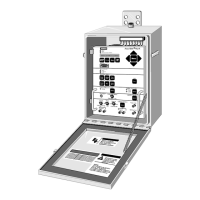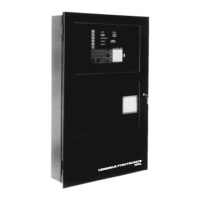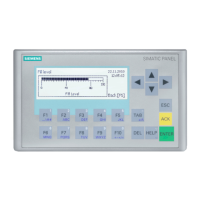4 Setting Up the MJ-5 Control Panel
Siemens Industry, Inc. 27
VRC Mode
This data item defines the VRC mode of operation. Select
the desired mode, using the VRC Mode data item. Four
options are provided: OFF, LOCAL, REMOTE, and
AUTO/REM (see Figure 4.4).
VRC Mode: OFF
This setting disables the VRC function.
VRC Mode: LOCAL
When Local mode is selected, VRC activates immediately
to reduce output voltage by the amount specified in the
Local VRC % data item.
To enable VRC Local mode, view VRC Mode and select
LOCAL. View Local VRC % and define a reduction
amount between 0.0% and 10.0% in 0.1% increments.
VRC Mode: REMOTE (via Terminal Contacts)
When this mode is selected, VRC is conditioned to activate
VRC upon closure of external contacts. These contacts,
which specify the reduction amount, are connected to
terminals (labeled VRC1 and VRC2) at the rear of the
controller. See Appendixes I and K.
Note that VRC Mode: Remote works differently than VRC
Mode: Local. When you enable VRC Mode: Local, voltage
reduction begins immediately. When you enable VRC
Mode: Remote, the microprocessor is only conditioned to
activate VRC. Voltage reduction does not occur until the
VRC contacts are activated.
To enable VRC Remote mode, view VRC Mode and select
REMOTE. Then to activate voltage reduction, you must
close the appropriate VRC contacts.
Remote mode is further subdivided into MJ-X mode and
MJ-3A mode (compatible with the previous-generation
control). Both modes use the VRC terminal pairs; the
difference is in the way the terminal pairs are used.
MJ-X Mode (“Static” Inputs)
In MJ-X mode, you can specify up to three Stages of
voltage reduction—each with a different reduction value.
View VRC Remote and select MJ-X. Then view VRC
Stage1, VRC Stage2, and VRC Stage3 to set the VRC
percentage reduction values.
Two terminal pairs (VRC1 and VRC2) on the external
terminal block are used to trigger the three Stages (see
Table 4.4).
Table 4.4 VRC Indicator Flashing Pattern for MJ-X Mode
MJ-3A Mode (“Pulsed” Input)
This mode simulates MJ-3A VRC; it uses only one external
contact (VRC1). MJ-3A VRC users can achieve
compatibility with existing controllers using this mode.
To use MJ-3A mode, view VRC Remote and select MJ-3A.
Then select MJ-3A VRC% and specify the reduction value.
The single MJ-3A VRC% value defines a total reduction
value which control program logic subdivides into 33%,
67% and 100% steps.
To achieve a reduction equal to 100% of the MJ-3A VRC%
specification, activate the VRC1 contact for more than
three seconds (“latched”). To achieve partial voltage
reduction, “pulse” the VRC1 contact momentarily (a
“pulse” is 300 msec. to 3 seconds). See Table 4.5 below.
Table 4.5: MJ-3A Mode VRC Reduction
For example, if you specify Fwd Volts=120 V, and MJ-3A
VRC% = 10%, the total reduction value is 12 V. This 12 V
reduction value is further subdivided into thirds, so a single
pulse would result in a 4 V reduction; a second pulse would
produce an 8 V reduction; and a third pulse would produce
a 12 V reduction. Contact activation of three seconds or
longer is considered to be a “latched condition” and would
(in this example) produce a full 12 V reduction.
Automatic Mode VRC with Remote Override
In Automatic mode, voltage reduction is activated
automatically whenever load current exceeds a predefined
percentage.
There are two automatic VRC set points (AutoVRC1 and
AutoVRC2). When load current exceeds the percentage
specified in either of the AutoVRC %I data items, regulator
output voltage is reduced by the percentage specified in the
corresponding AutoVRC set data item.
Only one set is active at a time; they are not additive.
AutoVRC remains active until the load current falls below
a value that is the lower of:
AutoVRCn% · (1-2 · AutoVRCsetn(%))
or
VRC1 iactive: VCR2
in-active
VRC1 in-active:
VRC2 active
fourth pulse 0% not flashing

